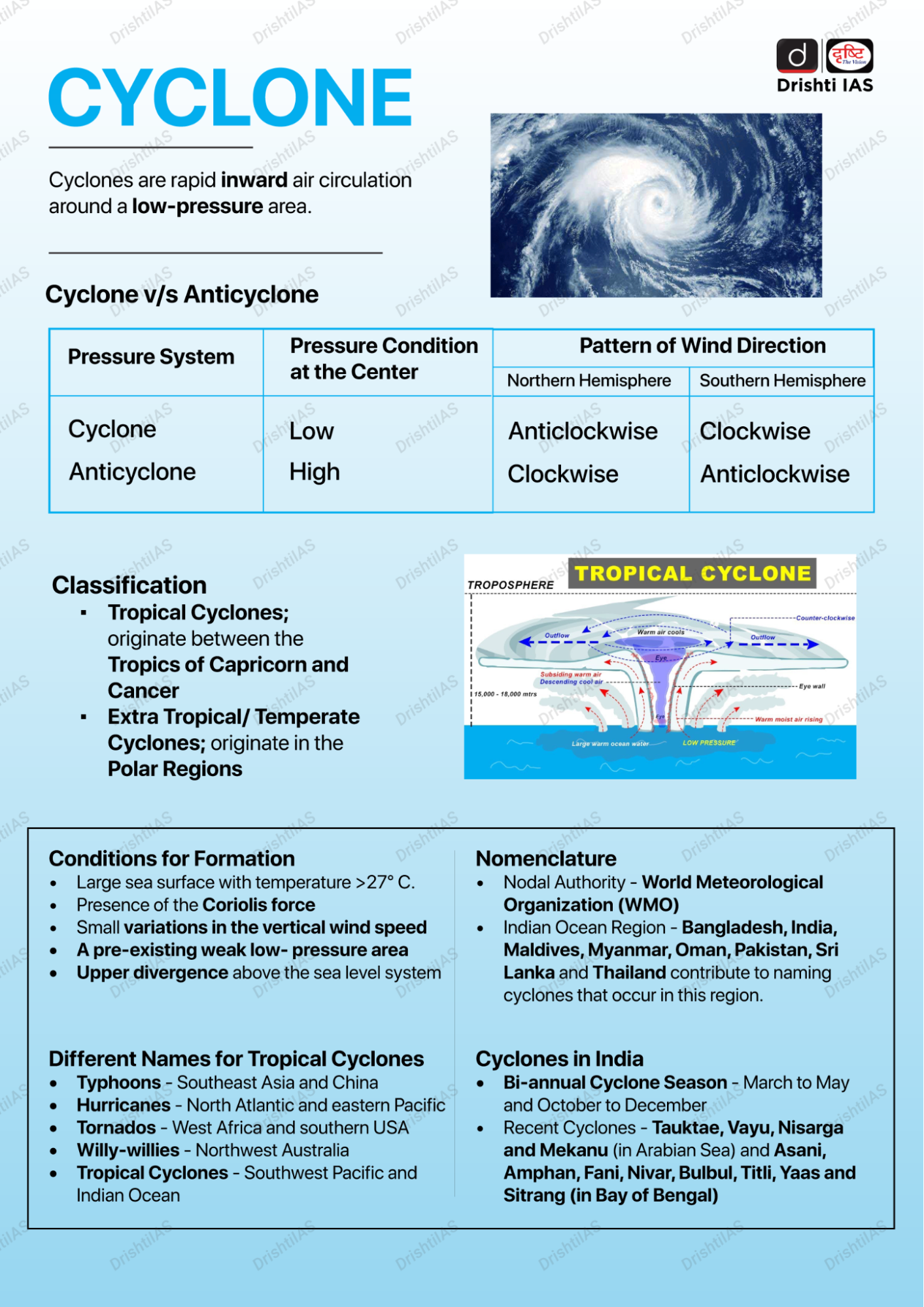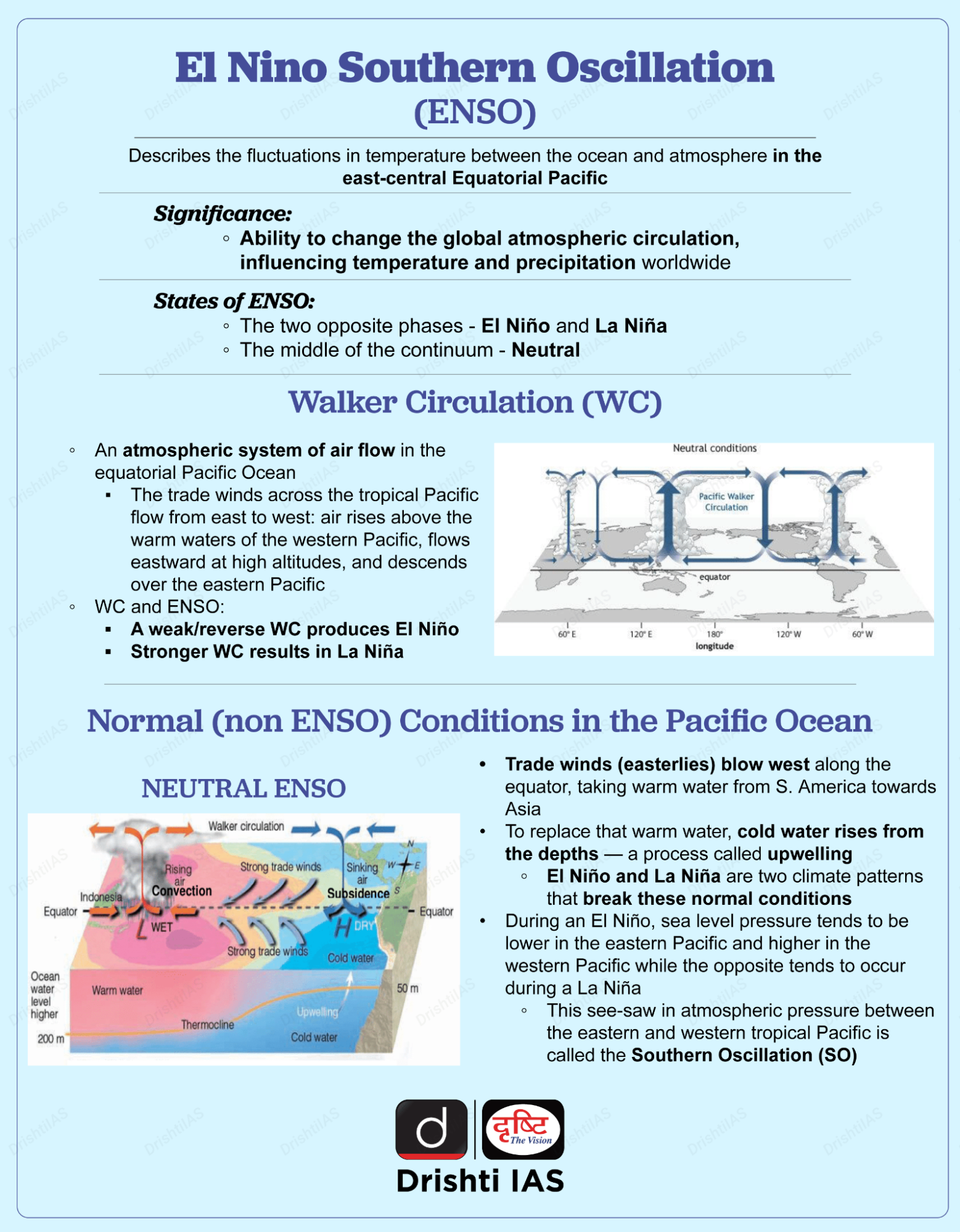Equatorial Origin Cyclones and Pacific Decadal Oscillation | 30 Aug 2023
For Prelims: Tropical Cyclones, Low Latitude Cyclones, Pacific Decadal Oscillation (PDO), ENSO
For Mains: Impact of PDO on India, ENSO vs PDO
Why in News?
Equatorial-origin cyclones have been unusually subdued in recent decades.
- However, as per a study published in the journal Nature Communications, the combination of global warming and the Pacific Decadal Oscillation (PDO) could make such cyclones more frequent in the coming years.
What are Equatorial-Origin or Low Latitude Cyclones?
- Equatorial origin or Low Latitudes Cyclones (LLCs) originate between 5°N and 11°N. These cyclones are much smaller in size than those in higher latitudes but intensify more rapidly.
- Cyclones forming near the equator (low-latitude) is usually rare but when the waters are warm, they can gain more moisture and rise in intensity.
- Majority of cyclones originate in the Western Pacific Ocean.
- Cyclones forming near the equator (low-latitude) is usually rare but when the waters are warm, they can gain more moisture and rise in intensity.
- The last major cyclone of this kind in the Indian neighbourhood was the 2017 Cyclone Ockhi which travelled >2000 km and devastated Kerala, Tamil Nadu and Sri Lanka.
- The north Indian Ocean (NIO) in the post-monsoon season (Oct-Nov-Dec) is a hotbed for LLCs that constitute about 60% of all Tropical Cyclones formed in the NIO (since 1951) but has received relatively less attention.
What is Pacific Decadal Oscillation?
- About:
- The Pacific Decadal Oscillation (PDO) is a long-term ocean fluctuation of the Pacific Ocean. It is a cyclical event that repeats every 20-30 years and just like ENSO, has a ‘cool’ and ‘warm’ phase.
- Positive (warm) PDO = cooler west Pacific Ocean and warmer eastern side (vice versa for negative PDO).
- The term PDO was coined in about 1996 by Steven Hare.
- Impact of PDO:
- On Global Climate: PDO phase can have significant implications for the global climate, affecting Pacific and Atlantic hurricane activity, droughts and flooding around the Pacific basin, the productivity of marine ecosystems, and global land temperature patterns.
- On Cyclones: A warmer (positive-phased) PDO implies fewer equatorial-origin cyclones.
- In 2019, the PDO entered a cooler, negative phase and which if continues, could mean more such cyclones in post-monsoon months.
- ENSO and PDO:
- ENSO with a positive PDO is generally not good, however, ENSO with a negative PDO brings more rain to India.
- If both ENSO and the PDO are in the same phase, it is believed that El Niño/La Nina impacts may be magnified.
- PDO vs ENSO:
- El Nino or La Nina events repeat in the Pacific over 2-7 years, however, PDO has a signature for a longer time (on the decadal scale).
- A ‘positive’ or ‘warmer phase’ of a PDO can be known only after several years of measuring ocean temperatures and their interaction with the atmosphere (stage of an ENSO can be determined any year).
UPSC Civil Services Examination, Previous Year Question (PYQ)
Prelims:
Q. La Nina is suspected to have caused recent floods in Australia. How is La Nina different from El Nino? (2011)
- La Nina is characterised by an usually cold ocean temperature in equatorial Indian Ocean whereas El Nino is characterised by unusually warm ocean temperature in the equatorial Pacific Ocean.
- El Nino has adverse effect on south-west monsoon of India but La Nina has no effect on monsoon climate.
Which of the statements given above is/are correct?
(a) 1 only
(b) 2 only
(c) Both 1 and 2
(d) Neither 1 nor 2
Ans: (d)
Mains:
Q. Most of the unusual climatic happenings are explained as an outcome of the El-Nino effect. Do you agree? (2014)
Q. Tropical cyclones are largely confined to the South China Sea, Bay of Bengal and Gulf of Mexico. Why? (2014)


